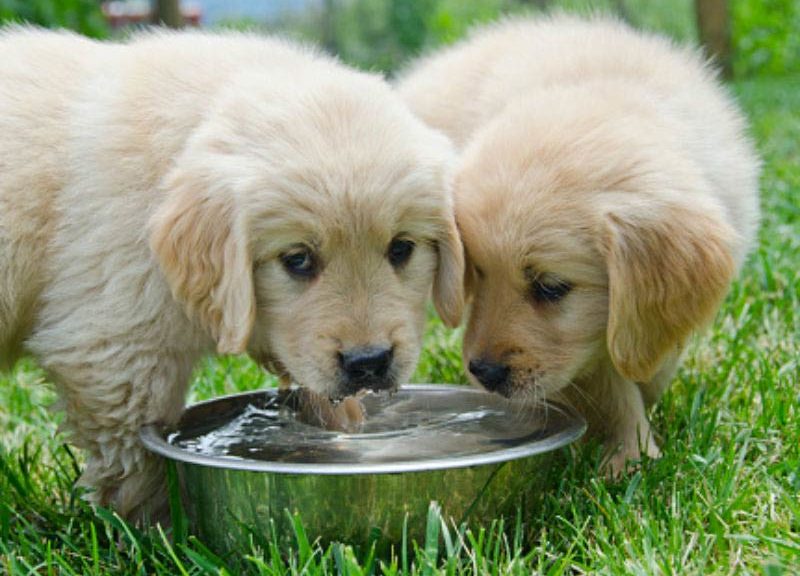Puppies consume a lot of food and liquids as they are still growing. Additionally, your puppy is probably always playing and running around, which can dehydrate him.
But how can you tell if your puppy is consuming enough or too much water?
Table of Contents
Why Puppies Need More Water?
When a puppy is young, water makes up 85% of its body; this proportion drops to 60% as the puppy ages. Their mother’s milk provides them with the necessary hydration while they are still puppies. Water is crucial for aiding in digestion once they are weaned and start eating kibble.
Dogs need water to grow and develop their muscles. Additionally, it plays a significant role in the body’s overall metabolic process, which also includes breathing, digestion, blood flow to the brain, and liver and kidney function.
Drinking water is crucial for replenishing the moisture lost from a dog’s tongue, nasal passages, and lungs because a dog cools himself by panting. The ability to smell is aided by the moist nose of a dog who is properly hydrated.
How Much Water Should My Dog Drink?
0.5 cups of water every two hours are required for young puppies who are switching from mother’s milk to solid food. Once they’ve been weaned, they should be drinking between 0.5 to 1 fluid ounce per pound of body weight each day.
The best way to ensure that your puppy is getting enough water to drink is to create a schedule. Limit his water intake rather than leave a bowl out for him to chug at will. Add the right amount of water to his drinking bowl every few hours, then call your puppy. Encourage him to drink the water, and when he does, commend him and engage in some playtime with him.
The majority of dogs learn to drink enough water on their own, but it’s crucial to watch them closely when they first start. Dehydration can result from not getting enough water, but it can also happen when you get too much.
How Much Water Should A Puppy Drink During Potty Training?
You can give your puppy water all day long, but before he goes to sleep, take it away so he won’t need to use the restroom as frequently.
“While you should let your puppy drink as much as they want during the day, you might want to take away their drinking bowl two to three hours before bedtime to lessen the frequency of their overnight bathroom breaks, advises Dr. Bourjaily said.
Similar to how you feed him at roughly the same times each day, try to remove his water at roughly the same time each night to establish a routine.
Additionally, bear in mind that your puppy will likely need to use the restroom within 10 to 30 minutes of drinking water until he is old enough to control his bladder (around 9 months). If he drinks continuously throughout the day, you will need to take him outside frequently.

7 Factors That Affect How Much A Puppy Drinks
There are seven variables that can affect how much water a puppy or adult dog needs to consume.
- Canine food versus dry dog food. Canine food can have 50% to 75% water content, compared to dry food’s 15% to 30% water content range. Canine consumers may drink more water and need less of it.
- Body weight. Weight affects how much water the body needs. Dogs that are larger than smaller dogs need more water.
- Disease. Increased thirst in dogs can be a symptom of conditions like diabetes and kidney disease.
- Drug therapy. Steroids and diuretics like furosemide are some medications that cause dogs to drink more water.
- Sodium intake. Similar to how our thirst increases after eating a high-salt snack, dogs who consume too much sodium may also feel the need to drink more water.
- Activity and exercise. More active dogs drink more water and need it more frequently.
- Weather exposure. Dogs pant in the spring and summer due to the high temperatures. Though it causes water loss, panting aids in their ability to control body temperature.
How To Tell If Your Puppy Is Dehydrated
Your puppy may be suffering from dehydration if they exhibit lethargic behavior, stop eating or drinking, vomit, or have diarrhea. You can check a puppy’s condition by looking at them to see if they’re dehydrated. The following are physical indicators of dehydration:
- depression and lethargy. Dehydrated dogs experience discomfort, are lethargic, and exhibit decreased activity levels. Puppies with dehydration lack energy and sleep more.
- Sticky gums. When you touch the gum tissue of a puppy who is properly hydrated, it feels moist and slippery. Dogs who are dehydrated will have gums that are dry and tacky.
- Slow skin tent test. The skin tent test is a typical test for dehydration. Pull up gently on the loose skin covering the back of the neck to conduct this test. The skin will return to its original position quickly during typical hydration. Dehydrated animals’ skin will heal more slowly than normal. It may take some practice to distinguish between them, and breed and age can have an impact as well.
- Sunken eyes. Pets who are severely dehydrated will have lost a lot of fluid, which leaves their eyes looking dull and sunken.
Your puppy should continue to be healthy and hydrated as long as you’re giving him plenty of fresh water every day. However, call your veterinarian if you see any signs of dehydration in your puppy or if you notice them drinking more than usual.
